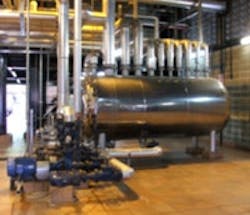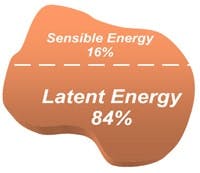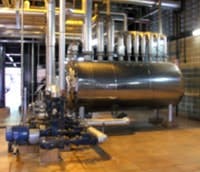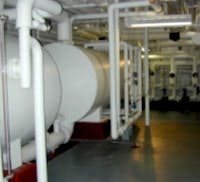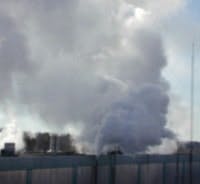Figure 1. Latent and sensible energy percentages.
Steam contains two types of energy: latent and sensible. When steam is supplied to a process application (heat exchanger, coil, tracer, etc.) the steam vapor releases the latent energy to the process fluid and condenses to a liquid condensate. The condensate retains the sensible energy the steam had. The condensate can have as much as 16% of the total energy in the steam vapor, depending on the pressure (Figure 1).
Figure 2. This is an example of a condensate return tank that was designed to meet today’s industrial standards.
One of highest return on investments is to return condensate to the boiler. As fuel costs continue to rise, it’s imperative to focus on recovering condensate in every industrial steam operation.
Condensate contains not only water, but also boiler treatment chemicals and the energy transferred during combustion. Condensate, therefore, needs to be returned to the boiler to:
- Improve energy efficiency
- Reduce chemical cost
- Reduce make-up water costs
- Reduce sewer system disposal costs
- Meet environmental regulations
Figure 3. A totally insulated condensate system can pay for itself in thermal efficiency.
Unfortunately, many industrial plants waste the condensate from the steam system and aren’t returning condensate to the boiler plant. Condensate being returned still loses thermal energy because of uninsulated tanks, condensate pipe, valves and fittings. The best practice for condensate systems is to insulate any device in the condensate system to prevent such losses (Figure 3).
If condensate isn’t returned to the boiler, the steam system must make up the loss with cold, untreated, raw water that has to be prepared for boiler operation. This preparation has a cost. The make-up water also contains substantially less BTU content that must be raised in the deaerator or atmospheric feed water heater. This energy addition adds even more cost to the operation. The raw water has to be chemically prepared for the boiler operation, which is an added cost.
Justification to return condensate
With high energy costs, you must return as much condensate as possible to the boiler plant for reuse. The benchmark for optimal condensate return is as high as 90%. This is possible if the plant doesn’t use direct steam injection for process applications.
Below is an illustration of the potential savings of a 44,000 lb/hr, 150 psig steam system with no condensate returned to the boiler plant:
| Average steam flow (lbs per hr) | 44,000 |
| Unloaded fuel cost ($ per MBTU) | 15.3 |
| Operation (hr/yr) | 8,760 |
| Operating steam pressure (psig) | 150 |
| Steam temperature (°F) | 366 |
| Steam total energy (hg) BTU/lb | 1195.1 |
| Makeup water temperature (ºF) | 55 |
| Makeup water BTU content (hm) BTU/lb | 23 |
| Condensate return temperature (ºF) | 212 |
| Returned condensate energy (hc) BTU/lb | 180.33 |
| Benchmark fraction of condensate returned (decimal percent) | 0.90 |
Table 1. This is the basic data for the example calculation, which represents a typical operating steam system. |
|
To determine potential energy losses per year, based on zero condensate returned to the boiler point, follow the calculation below:
- (hc – hm) = energy loss per lb of condensate
- (180.33 – 23) = 157.33 BTU per lb of condensate
- 44,000 lbs of steam = 44,000 lbs of condensate (90% return) = 39,600 lbs
- 39,600 lbs x 157.33 BTU per lb = 6,230,268 BTU/hr
- 6.230268 x $ 15.3 = $95.32/hr
- $95.32 x 8,760 hours per year = $835,003/yr
The potential savings is based on the energy required to elevate the make-up water to that of the condensate being returned. The calculation doesn’t take into account the savings from chemicals, water and sewer costs. It also doesn’t consider the effect of bringing condensate back at higher pressures, resulting in greater savings. The above calculation assumes no condensate is being returned to the boiler, but most industrial plants return at least a small percentage of condensate. Each plant should evaluate the cost of failing to return condensate and set forth a roadmap for returning condensate.
Killing cost
[pullquote]
If condensate is returned, the need for make-up water is reduced. Dropping the make-up water quantity yields a lower consumption of boiler chemicals. Water costs are rising everywhere and a high condensate return ratio reduces the total make-up water costs.
Sewer system costs are directly related to the intake of water. If condensate is not returned, condensate is being drained to the sewer, adding to the cost for processing the sewer waste. Finally, the law might require drain water to be treated. Condensate returned to the boiler process reduces the water sent to the drain and the volume of water that falls under regulatory control.
What prevents condensate return?
One must understand the factors that prevent the condensate from being returned to the boiler if the plant wants to establish corrective methods. The first is selecting condensate pumps having the proper net positive suction head (NPSH). A number of condensate pumps handle only condensate temperatures of less than 200ºF (93°C). Condensate temperatures are close to the atmospheric saturation temperature of 212°F (100°C). Therefore, NPSH is a critical variable. Failure to have the proper NPSH rating results in pump cavitation, damaging the seals and impeller in a short period of time.
Steam traps are the next factor. Undersizing and improper installation of steam traps causes the traps to malfunction. Too often, a short solution to the problem is to drain the condensate to sewer. Many steam trap installations have drain valves open to remove the condensate from the process so processes can reach proper temperatures.
Figure 4. Steam leaks are a loss of condensate and energy.
Figure 5. Steam blowing to atmosphere represents a great loss of steam and condensate.
Another factor is condensate line corrosion. The condensate system accumulates carbonic acid as a result of excessive carbon dioxide in the system. The highest concentration is in the condensate return lines because carbon dioxide dissolves in cooling condensate. Most condensate lines use Sch 80 steel pipe and threaded connections. Condensate corrodes steel, but the pipe threads typically are more susceptible to deterioration. Using stainless for condensate pipe and valves, and avoiding threaded connections, slows the corrosion.
The fourth factor is condensate system insulation. Steam system components should be insulated to ensure the thermal energy in the condensate isn’t lost in transit. Also, insulation protects personnel from contact with hot components, thus improving plant safety. Everything in the condensate system at a temperature above 120°F (49ºC) needs insulation, including:
- Condensate lines
- Condensate tanks
- Valves
- Some steam trap types
The last factor is leaks and flash steam losses (Figures 4 and 5). Leaks from malfunctioning components in the steam and condensate system contribute to loss of treated condensate. Tanks that vent to atmosphere also lose condensate.
Condensate is one of the top five items that must be targeted in a steam and condensate system to reduce energy cost and improve reliability. The other four are:
- Venting steam to atmosphere
- Leaks
- Insulation
- Steam trap management
Kelly Paffel is the technical manager at Inveno Engineering, LLC. Mr. Paffel is a recognized worldwide authority in industrial steam systems. He has has 35 years of experience in steam, compressed air systems and power operations. Mr. Paffel has achieved Steam System Level V certification in Steam Systems and is also is also a member of the Department of Energy’s (DOE) Steam Best Practices Committee and Steam Technical Committee.
Images courtesy of Swagelok Company
